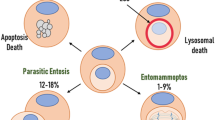Abstract
In 1984, Philippe Shubik wrote in an editorial in the Journal of the National Cancer Institute [1] that:
‘In terms of general biology, the multicellular organisms have evolved a complex series of defensive responses to extracellular injury involving various inflammatory reactions and their systemic concomitants. Needless to say, these reactions are by no means always successful from the standpoint of the host and indeed may well be the immediate cause of the obvious ill effects noted.
The unicellular organisms, in contrast, react to injury by dividing and moving.
In the search for the features that may link chemical, physical, and viral carcinogens apart from their ability to induce neoplasia, only one characteristic in common is obvious, namely, their ability to produce intracellular change or injury while leaving the cell viable. Perhaps the initial and fundamental characteristic of neoplasia is a reversion of the cell to unicellular behavior. Division and invasiveness are the characteristics of the neoplastic cell, and increased motility certainly seems to be the most likely mechanism for invasion’.
Dr. Shubik presented these views as a basis for ‘further discussion’ regarding the nature of the neoplastic response. We hope that this presentation will augment Shubik's plea by reviewing his idea in the context of our current knowledge of tumor development. In addition, we will attempt to integrate the concept of the unicellular behavior of tumor cells with Foulds' [2] and subsequently Nowell's [3] insightful hypothesis concerning tumor progression.
Similar content being viewed by others
References
Shubik, P: Progression and promotion. J Natl Cancer Instit 73: 1005–1011, 1984
Foulds L: In: Neoplastic Development. Academic Press. pp 675–693, 1975
Nowell, PC: The clonal evolution of tumor cell populations. Science 194: 23–28, 1976
Vogelstein, B, Fearon, ER, Hamilton, SR, Kern, SE, Preisinger, AC, Leppert, M, Nakamura, Y, White, R, Smits, AMM, Bos, JL: Genetic alterations during colorectal-tumor development. New Engl J Med 319: 525–532, 1988
Kendall, W, Frost, P: Genetic instability and tumor progression. Pathol Immunopath Res 5: 455–467, 1986
Fenner FJ, White DO: In: Medical Virology (2nd edition). Academic Press. pp 86–91, 1976
Ullrich, SJ, Robinson, EA, Law, LW, Willingham, M, appella, E: A mouse tumor-specific transplantation antigen is a heat shock-related protein. Proc Natl Acad Sci 83: 3121–3125, 1986
LaThanque, NB, Latchman, DS: A cellular protein related to heat-shock protein 90 accumulates during Herpes Simplex virus infection and is overexpressed in transformed cells. Exp Cell Res 178: 169–179, 1988
Ames, BN, Magaw, R, Gold, LS: Ranking possible carcinogenic hazards. Science 236: 271–280, 1987
Frost, P, Kerbel, RS, Bauer, E, Tartamella-Biondo, R, Cefalu, W: Mutagen treatment as a means for selecting immunogenic variants from otherwise poorly immunogenic murine tumors. Cancer Res 43: 125–132, 1983
Bernards, R, Dessain, SK, Weinberg, RA: N-myc amplification causes down-modulation of MHC class I antigen expression in Neuroblastoma. Cell 47: 667–674, 1986
Hayashi, H, Fanaka, K, Jay, F, Khoury, G, Jay, G: Modulation of the tumorgenicity of human adenovirus-12-transformed cells by interferon. Cell 43: 263–267, 1985
Kunkel, TA, Alexander, PS: The base substitution fidelity of eucaryotic DNA polymerases. J Biol Chem 261: 160–166, 1986
Michalopolous, G: Liver regeneration: Molecular mechanisms of growth control. FASEB J 4: 176–187, 1990
Braun, L, Mead, JE, Panzica, M, Mikumo, R, Bell, GI, Fausto, N: Transforming growth factor β mRNA increases during liver regeneration: A possible paracrine mechanism of growth regulation. Proc Natl Acad Sci 85: 1539–1543, 1988
Bell, C, Pathak, S, Frost, P: Unknown primary tumors: Establishment of cell lines, identification of unique chromosomal abnormalities and implications for a second type of tumor progression. Cancer Res 50: 4311–4315, 1989
Pathak, S, Dhaliwal, MK: Cytogenetic analysis of a liomyosarcoma cell line SK-UT-JB: Normal diploid or with 21q deletion? Cancer Genet Cytogenet 41: 145–147, 1989
Nigro, JM, Baker, SJ, Preisinger, AC, Jessup, JM, Hostetter, R, Cleary, K, Bigner, SH, Davidson, N, Baylin, S, Devilee, P, Glover, T, Collins, FS, Weston, A, Modali, R, Harris, CC, Vogelstein, B: Mutations in the p53 gene occur in diverse human tumor types. Nature 342: 705–708, 1989
Knudson, AG: Hereditary cancer, oncogenes and antioncogenes. Cancer Res 45: 1437–1443, 1985
Author information
Authors and Affiliations
Rights and permissions
About this article
Cite this article
Frost, P., Chernajovsky, Y. Transformation injury and the unicellular phenotype of malignant cells. Cancer Metast Rev 9, 93–98 (1990). https://doi.org/10.1007/BF00047591
Issue Date:
DOI: https://doi.org/10.1007/BF00047591




